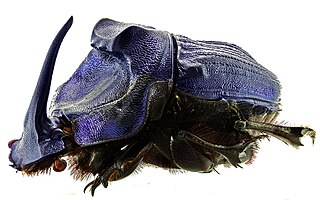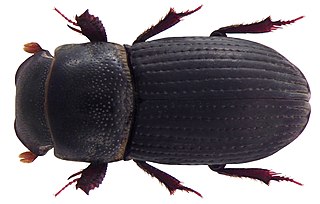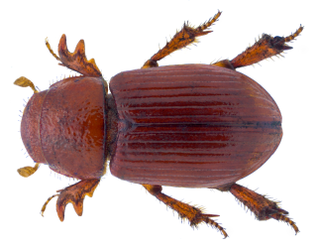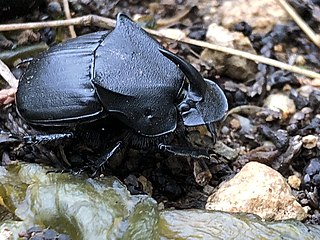
Coprophanaeus is a genus in the family Scarabaeidae. The genus is almost entirely Neotropical, with a single species, C. pluto, ranging into southernmost Texas in the United States. They are medium-sized to large beetles, with the South American C. ensifer and C. lancifer sometimes exceeding 5 cm (2 in) in length, making these two some of the largest dung beetles in the world and the largest in the Americas. They often have a horn on the head, and are typically a bright metallic color, most often blue or green, or black. These diurnal or crepuscular beetles are excellent diggers and good fliers.

Coprophanaeus ensifer is a large South American species of beetle belonging to the family Scarabaeidae.

Sulcophanaeus imperator is a brightly colored species of dung beetle belonging to the family Scarabaeidae. This diurnal, coprophagous beetle is native to south-central South America and generally common. It is paracoprid, meaning that adults dig tunnels into the soil under the food source and move parts of the food source to a nest chamber where the eggs are laid.

Oxysternon is a Neotropical genus of scarab beetles (Scarabaeidae) in the superfamily Scarabaeoidea. It can be distinguished from all other phanaeines and scarabaeine dung beetles by a long, spiniform extension of the anterior angle of the metasternum. Most species vary in color and pattern, and are more commonly found in tones of green, often infused with yellow or coppery highlights. All species appear very smooth or glassy smooth to the unaided eye.
Australaphodius is a genus of aphodiine dung beetles in the family Scarabaeidae. There are at least four described species in Australaphodius.
Odontolytes is a genus of aphodiine dung beetles in the family Scarabaeidae. There are about 19 described species in Odontolytes.

Ateuchini is a tribe of dung beetles in the family Scarabaeidae. There are at least 30 genera and 370 described species in Ateuchini.

Pseudocanthon is a genus of in the beetle family Scarabaeidae. There are about nine described species in Pseudocanthon.
Parataenius is a genus of aphodiine dung beetles in the family Scarabaeidae. There are about six described species in Parataenius.

Dialytes is a genus of aphodiine dung beetles in the family Scarabaeidae. There are about five described species in Dialytes.
Podolasiini is a tribe of May beetles and junebugs in the family Scarabaeidae. There are at least 2 genera and about 18 described species in Podolasiini.

Tesarius is a genus of aphodiine dung beetles in the family Scarabaeidae. There are about five described species in Tesarius.
Parapsammodius is a genus of aphodiine dung beetles in the family Scarabaeidae. There are at least four described species in Parapsammodius.

Rhysothorax is a genus of dung beetles in the family Scarabaeidae, containing only one species, R. rufus. It has at times been classified as a subgenus within Aegialia.
Coprophanaeus pluto is a species of dung beetle in the family Scarabaeidae. It is found in Guatemala, Mexico and southernmost Texas ; it is the only species of Coprophanaeus in the United States. This black beetle feeds on carrion and typically is 1.8–2.8 cm (0.7–1.1 in) long.
Martineziana is a genus of aphodiine dung beetles in the family Scarabaeidae. There are about six described species in Martineziana.
Oncerini is a tribe of May beetles and junebugs in the family Scarabaeidae. There are at least two genera and two described species in Oncerini.
Malagoniella is a genus of in the beetle family Scarabaeidae. There are about 10 described species in Malagoniella.

Phanaeus triangularis, the black phanaeus, is a North American species of true dung beetle in the family Scarabaeidae. It is found in the eastern half of the United States.

Coprophanaeus lancifer is a large species of beetle belonging to the family Scarabaeidae. It is found widely in the Amazon rainforest in South America and it is often common.











